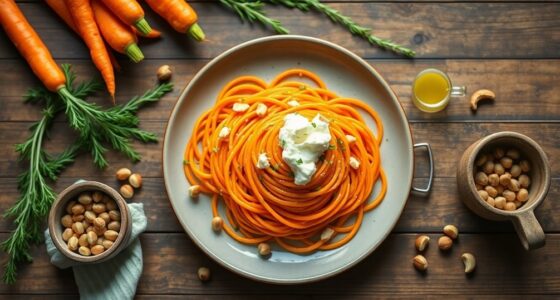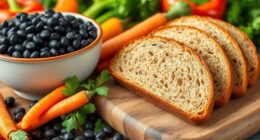During your eating windows, plan balanced, nutrient-dense meals that include lean proteins, healthy fats, complex carbs, and plenty of vegetables to keep you satisfied and energized. Batch cook ingredients to simplify meal prep, and choose snacks like nuts, yogurt, or sliced vegetables with hummus for convenience. Focus on colorful, well-rounded plates that help prevent hunger crashes and support your fasting goals. Keep exploring how to optimize your meals for sustained success.
Key Takeaways
- Plan balanced meals with lean proteins, healthy fats, complex carbs, and vegetables to support nutrient intake during eating windows.
- Batch cook versatile ingredients like roasted vegetables and grilled proteins for quick, varied meal assembly.
- Incorporate nutrient-dense snacks such as nuts, Greek yogurt, or sliced vegetables to maintain satiety between meals.
- Use proper storage techniques to keep prepped meals fresh, flavorful, and ready for quick consumption.
- Focus on colorful, well-rounded plates that balance vegetables, proteins, and healthy carbs to optimize energy and adherence.

Intermittent fasting has become a popular way to improve health and manage weight, but knowing what to eat during your eating windows can be challenging. The key to success lies in planning your meals carefully, so you stay satisfied and nourish your body adequately. Meal prep becomes essential here—by preparing your food in advance, you reduce the temptation of grabbing unhealthy snacks or skipping meals altogether. Focus on creating balanced plates that include a good mix of lean proteins, healthy fats, complex carbs, and plenty of vegetables. This approach not only keeps you full longer but also provides sustained energy throughout your fasting period. When it comes to snack options, choose nutrient-dense choices that support your goals without breaking your fast prematurely or causing blood sugar spikes. Examples include nuts, seeds, Greek yogurt, or sliced vegetables with hummus. These snacks are easy to prepare and can be portioned out ahead of time, making it convenient to stick to your fasting schedule.
During your eating windows, aim for colorful, well-rounded meals. Incorporate a variety of vegetables to ensure you’re getting enough fiber, vitamins, and minerals. Pair these with moderate portions of lean proteins like chicken, fish, or tofu, which help maintain muscle mass and promote satiety. Whole grains such as quinoa, brown rice, or oats provide complex carbohydrates that deliver slow-burning energy, preventing hunger crashes later in the day. To make meal prep even more effective, batch cook larger quantities of these ingredients and assemble different meals throughout the week. For example, roasted vegetables and grilled chicken can serve as the base for salads, wraps, or bowls, so you’re never left wondering what to eat. When constructing your plates, aim to fill half with vegetables, a quarter with lean protein, and the rest with healthy fats and grains. This balanced approach supports sustained fullness and nutritional balance. Incorporating proper storage techniques can also help keep your prepped meals fresh and tasty throughout the week.
Snacks play an essential role in bridging the gap between meals, especially if you experience long fasting periods. Keep your snack options simple, portable, and nutrient-packed. Hard-boiled eggs, cottage cheese, or a handful of almonds are excellent choices that require minimal prep. If you prefer something crunchy, sliced cucumbers or carrots with hummus work well. These snacks help curb cravings without derailing your progress. Remember, the goal is to choose foods that fuel your body, keep you energized, and satisfy your hunger, all while fitting within your eating window. By planning your meals and snacks thoughtfully, you’ll find it easier to adhere to your intermittent fasting routine, stay motivated, and enjoy the process of nourishing your body effectively.
Frequently Asked Questions
Can I Drink Coffee During Fasting Periods?
Yes, you can drink coffee during fasting periods. Coffee benefits include boosting your energy and suppressing appetite, making fasting easier. Just make sure you stay hydrated, so drink plenty of water alongside coffee for fasting hydration. Keep your coffee black or with minimal added calories to avoid breaking your fast. Enjoying coffee in moderation can help you stay alert and support your fasting goals without disrupting your fast.
How Do I Break a Fast Without Discomfort?
Breaking your fast carefully can prevent discomfort—that’s no myth. First, start with a small, gentle meal like fruit or yogurt, easing your digestion into meal timing. Don’t plunge into heavy foods too quickly, as fasting myths often lead you astray. Instead, listen to your body’s signals, and gradually reintroduce more substantial foods. This mindful approach helps you avoid bloating or cramps, making your fasting journey smoother and more sustainable.
Are There Specific Foods to Avoid During Fasting?
During fasting, avoid high-calorie, greasy, or processed foods that can cause discomfort or disrupt your fast. Instead, focus on low calorie snacks and gentle foods to break your fast, like fruits or yogurt. Stick to meal timing strategies that gradually reintroduce food, helping your stomach adjust. Avoid overeating or heavy meals right after fasting, and listen to your body’s signals to prevent any digestive issues.
How Long Should My Eating Window Be?
You should tailor your eating window based on your fasting duration and lifestyle. For most, a 16:8 schedule—fasting for 16 hours and eating within an 8-hour window—works well. This allows you to enjoy balanced meals while maintaining effective meal timing. If you’re new, start with shorter windows like 14:10, then gradually extend. Adjust the fasting duration to suit your energy levels and goals for sustainable success.
Can I Exercise While Fasting?
Absolutely, you can exercise while fasting, but think of it as dancing on a tightrope—you need exercise safety and patience. Start with light to moderate workouts, listen to your body, and give yourself time for fasting adaptation. As your body adjusts, you’ll find it easier to power through workouts without feeling drained. Always stay hydrated, and if you feel dizzy or weak, ease up—your body’s trying to tell you something.
Conclusion
Just like a well-tended garden thrives with the right balance of sunlight and water, your body flourishes when you choose nourishing, balanced meals during your eating window. I once tried intermittent fasting, and after a few weeks, I felt more energized—like my body finally found its rhythm. Remember, it’s not about strict rules but creating a sustainable routine that fuels your best self. Trust the process, and watch your health blossom.








